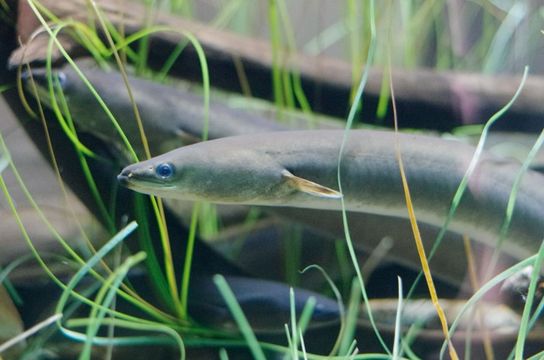Predator and Prey
The American eel interacts with many other species, both as a predator and as prey. We will take a look at the ecological role of the Anguilla rostrata from both sides.
Anguilla rostrata as a Predator:
Because of the broad differences in the life cycle stages of the Anguilla rostrata, the feeding habits at the separate stages vary quite drastically. According to the Encyclopedia of Life (EOL), the leptocephalus feeds on plankton as it grows and develops into the elver. At the elver stage, the American eel is more equipped for food intake and can eat a wider variety of fish parts, crustaceans, and aquatic insects (EOL).
Yellow and silver eels are nocturnal bottom dwellers and do most of their feeding at night, relying heavily of their excellent sense of smell, rather than sight, says the U.S. Fish and Wildlife Service (FWS). Because of their increased size and maturity, eels at this stage are able to feed on larger organisms, such as insects, worms, mollusks, and even other fish. They are able to swallow some things whole, but if the prey is too large, eels create a swift, forceful twisting motion with their bodies after clamping down on their food to tear off chunks that are small enough to ingest. This is called rotational feeding (EOL).
There are many environmental and physiological aspects that also play a role in the nutrition of the mature American eel. Differences in body size lead to differences in food intake. According to the Committee on the Status of Endangered Wildlife in Canada (COSEWIC), larger eels are more capable of feeding on crayfish and other fish, while the majority of the diet of smaller eels consisted of aquatic insect larvae.
The American eel’s diet can adapt to changes in the environment and the seasons, as well. During winter, the eel slows or completely stops its food intake. A cessation in feeding also occurs in preparation for the final migration back to the spawning sea (COSEWIC). The level of food intake can also be used as a coping mechanism for the American eel in response to the wide variety of temperature, salinity, and dissolved oxygen levels they encounter during their migrating lifecycle, slowing their metabolism when necessary (FWS).
Anguilla rostrata as Prey:
While American eel is a rather good predator, it also falls prey to other organisms. According to the Fish and Wildlife Service, eels, in all of their stages, can be a source of nutrition for other organisms in their ecosystem. Adult eels have been found to be eaten by eagles and gulls, eels in the middle of their development are eaten by large fish, and eels in the leptocephalus stage have been found to fall prey to many animals, including older eels!
The American eel can also provide for other species, in the sense of becoming a host to parasites or other microscopic organisms. While no species have been found to parasitize glass eels, the American eel from the elver stage up through adulthood is known to be the host for various trematodes, protozoans, nematodes, and cestodes. Parasitism by these organisms was shown to vary with age, and size of the host and the time of year (FWS).
Humans also have an impact on the success of the American eel. There is actually evidence that aboriginals in Canada began fishing of the Anguilla rostrata over 3000 years ago, mainly hunting them as a source of food and skin (COSEWIC). This tradition has continued and been taken up by sport fishermen, especially in the United States. There are, however, restrictions on the size of the eels harvested, the methods used, and permits required, in order to protect the wellbeing of the American eel (FWS).
If you're interested in finding out any of your own information about the American Eel check out the reference page!
